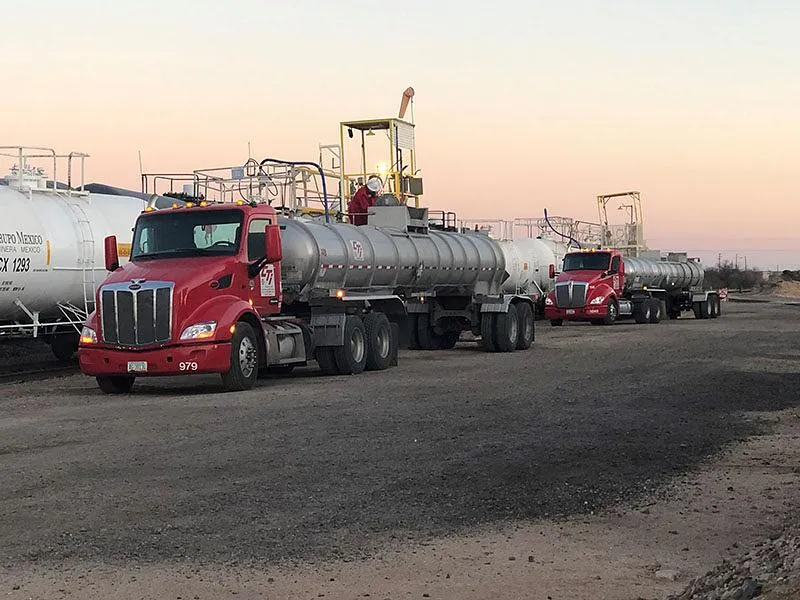(March 24, 2022) From chicken tenders to toilet paper, many of the most common everyday items have been harder than ever to come by in recent months. The same holds true for some of the supplies critical to sustaining Freeport-McMoRan’s business.
For example, the company recently was challenged with moving large quantities of molybdenum concentrate from Arizona to the company’s processing plant in Fort Madison, Iowa, within a week. That would be difficult in normal times, but even more so in today’s pandemic-driven supply chain bottlenecks. Backlogs have created intense competition for trucks, trains, ships and airplanes both in the United States and internationally.
Regardless, the order came through on a Monday afternoon that eight semi-trucks were needed the following morning to deliver by Friday. The site teams, planners, and logistics team all collaborated to find a solution.
Ultimately, all eight trucks were secured through an auction in which truckers compete against each other to bring down the price. Three shipments were delivered on Friday, with two on Saturday and the rest the following week. Everyone worked together to keep production going and to meet customer requirements.
That sort of juggling to fill transportation needs goes on daily for the company’s logistics team, said Bruce Nickle, Director-GSC Logistics and Transportation. So far, Freeport’s supply chain has been working well, and major disruptions have been avoided. The company has fixed contracts with a variety of rail lines, trucking companies and ocean shippers, which are functioning but with some delays. The problem is a lack of flexibility, so when something unusual occurs, it sets off a mad scramble to find alternative transportation.
That usually involves a tradeoff among time, money, operational and sales needs.
“The global freight market is the most congested it has been in decades,” Nickle said. “The company is not immune to these challenges, but everyone has banded together to find creative solutions.”
Nickle and his group handle the logistics of North American transportation, including transports between the U.S. mining operations and shipping of finished molybdenum and other products to customers overseas. They also arrange exports to other company properties in South America, Indonesia and Europe.
Global gridlock
There is some good news. Virtually all of the refined copper produced by Freeport in the U.S. is sold in North America, so, generally, deliveries to customers do not get tangled in oceanic shipping.
Deliveries to mining sites in North America for big items like equipment and repair parts normally are handled by the vendor, though Nickle’s team will take over logistics if that speeds delivery.
Molybdenum is a bigger challenge. Moly produced at the Cerro Verde mine in Peru is shipped to Houston or other Gulf of Mexico ports for delivery to processing plants, primarily those in Sierrita and Bagdad. Ocean shipping out of Cerro Verde is arranged in Peru. Nickle’s team handles transportation from Houston to the Arizona sites.
Another challenge for the logistics team is handling all shipments between North America and the PT Freeport Indonesia operation, including deliveries from suppliers, which is about 50 to 70 shipping containers per month. Shipping anything in the Pacific is especially tough due to the ports of Los Angeles being tied up.
Arranging for trucks is usually where the real juggling comes in. Railroads can carry large amounts of freight on predictable schedules and are being used as much as possible, Nickle said. But shipping by rail is slower, and there is little flexibility to acquire more capacity. Beyond that, not all sites have rail spurs, so mines like Bagdad and Safford rely exclusively on trucks.
Trucks are hard to come by. There is a nationwide shortage of drivers. Competition is intense and complicated by the fact that most of the company’s mining sites are in remote locations.
“We have faced every obstacle imaginable from a supply chain perspective,” Nickle said. “This is a global issue impacting every industry at some level, and I’m really proud of the way the Freeport team continues to navigate these challenging circumstances.”
Critical hub
The biggest logistical challenge is keeping products moving between sites within the U.S. The hub of it all, at least from a logistics standpoint, is the smelter in Miami, Ariz., said Logan Harper, Process Leader- Supply Chain and Bulk Logistics.
Copper concentrate from mining sites in Arizona and New Mexico feeds into the Miami smelter for processing. A byproduct of smelting is sulfuric acid, which is sent to the mines for leaching and electrowinning.
A breakdown in the Miami transportation network would jam up the entire North American operation, Harper said. Mines would not have the acid they need to extract copper. Nor would they have anywhere to send the Miami-bound copper concentrate they produce.
To expand capacity in Miami, the company is looking to increase rail service to the site from three days per week to four. The problem with that is finding new capacity in the transportation market where very little exists, and what does is costly, said Nickle, who is not expecting much letup in the supply chain problems until 2023.
In addition to the worldwide logistics challenges, Nickle’s team pays close attention to other global matters that could affect supply and demand, such as the current conflict in Ukraine and global recovery from the COVID-19 pandemic.
“The problem is we are competing with everyone else who is trying to do the same thing,” Nickle said. “My biggest concern in this next year is how I control costs. I think in 2021 we’ve proven that we can move material. It hasn’t been easy, but we’ve been able to do it. To me, this is a credit to the outstanding people at Freeport who have been working diligently to help ensure the needs of the business are being met.”
